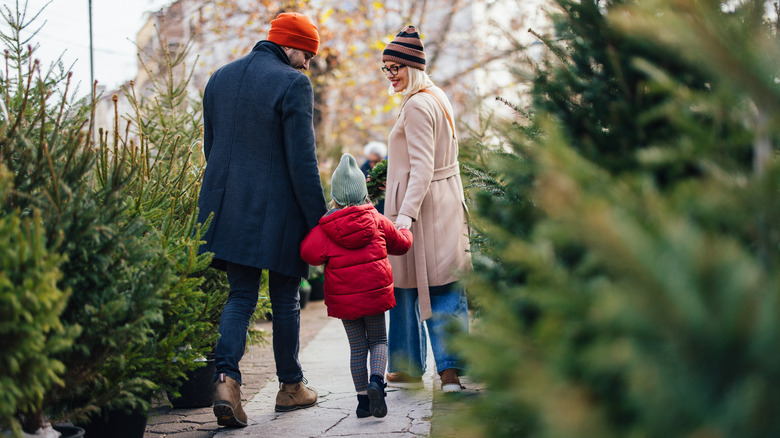What To Look For When Buying A Live Christmas Tree
Hands down, one of the best parts of the holiday season is having the scent of a fresh pine or fir tree filling your home. The tradition of choosing a real Christmas tree is a highlight for many people, just as much as finding a unique way to decorate it, but choosing the right tree can feel like a gamble. Will it last until Christmas day? Will it even fit in the living room? Skip the anxiety this year, and use these simple tips to find the best real Christmas tree on the lot.
The biggest pitfall when buying a live tree (and, honestly, the easiest one to avoid) is selecting one that was cut weeks ago and has already begun to dry out. Everybody hopefully knows that a dry tree is a fire hazard. And it'll only keep looking worse, turning a dull gray and shedding its needles. Yuck. To avoid this, focus on two tests while at the lot that'll reveal the tree's health and freshness.
First, perform the needle tug test. From a few different branches near the trunk, gently pull a few needles between your thumb and index finger. If a shower of needles falls in your hand, move on to the next tree. Healthy trees should hold onto green needles tightly. Sure, a few brown inner needles may shed (old growth), but the green needles should resist. Next, confirm the tree passes the color check. Needles should be vibrant green; dull grayish-green with yellow or reddish tips mean dehydration and poor health. Finally, inspect the needles. Healthy pines will bend, not break, while firs will snap cleanly.
How to pick the right-sized Christmas tree
Even though it was a funny moment in "National Lampoon's Christmas Vacation," nothing kills the festive spirit faster than dragging a beautiful tree into the living room only to realize it doesn't fit, leaving no room for a trendy tree topper. If you're not looking to re-enact that scene in your own home this holiday season, we recommend bringing a tape measure with you to the lot and a piece of paper listing the height and width of the area where the tree will be.
Before you head over to the tree lot, take a moment to measure the exact distance from the floor to the ceiling where the tree will stand. You should also factor in the height added by your tree stand and chosen tree topper and note that, too. Most stands add at least 6 inches of height (sometimes up to 12 inches), as they need to lift the trunk and store water for your tree. To be safe, the total height of your tree, including the stand and topper should be at least 6 inches less than your ceiling height so that you have a little visual breathing room. You can measure trees yourself at lots, but some tree lots may also have measuring and trimming services for you.
By taking a few moments to double-check measurements and perform a few freshness tests, it's easy to bring home a stunning, healthy tree. Now you're prepared to deck the halls and even enjoy some nostalgic Christmas trends.

